
In the episode “The Alternative Factor” from the first season of the Original Series, the Enterprise crew have their first encounter with alternative universes when they meet Lazarus and also Lazarus. In the second season’s “Mirror, Mirror,” viewers were presented with alternative versions of Kirk, Spock, and other crew members. This tried-and-true science fiction trope needs to be kept in mind when reading Star Trek: The Classic UK Comics Volume 1 (1969-1970) because these strips are a close variation of the Original Series, like the Gold Key comics.
In his introduction to the book, Rich Handley provides the history of the weekly UK strips, which debuted six months before Star Trek first aired in Britain and ran for five years, two more than the TV series ran. The stories, which aren’t attributed to any writers, are rather repetitive and seem intended for children due to their simplicity. There’s no social commentary or compelling themes, which the series was known for, and the plots usually resolve with the crew succeeding by firing their weapons rather than using their intellect.
Whoever was in charge of this comics project clearly put little thought into continuity, explaining the introduction of “Captain Kurt” of the “Universe Star Ship Enterprise” in the first couple of panels of the very first strip. There are many other inconsistencies throughout, from Spock’s emotions and incorrect uniform colors to an abundant use of shuttles instead of the transporter. There are also altered appearances of the Enterprise, Klingons, and Romulans (the latter of which are sometimes drawn as Romans).
The art by Harry F. Lindfield, Mike Noble, and Ron Turner is very good, with bright colors and fine details. The panels from issues #23-31 of TV21 & Joe 90 Weekly, mostly drawn by Jim Baikie, were printed in black and white, yet the quality isn’t diminished by the lack of hues. The art by Turner from Joe 90 Top Secret Annual is so wild it looks like a color code was created but no one had the key. The Enterprise is red, all uniforms are green, and skin tones change from panel to panel. It’s so unusual it works.
All aforementioned negatives are minor to my major complaint about the book. Because the strips that appear from Joe 90 Top Secret Weekly Issues1-34, pages 12-79, and TV21 & Joe 90 Weekly Issues 1-22, pages 86-129, were two-page spreads, the page format and book binding have led to an absolutely frustrating amount of gutter loss. It would be somewhat tolerable if only the art was hampered, but word balloons and captions are also affected, so bits of the story are lost.
For Trek completists who have never seen these strips or fans who read them decades ago, The Classic UK Comics might make for a fun read, but buyer beware. IDW Publishing and the Library of American Comics deserve kudos for compiling this rarely seen material into what will be a three-volume set, but I’d highly recommend looking inside Volume 1 before buying it.